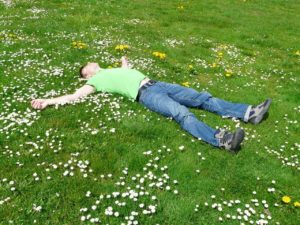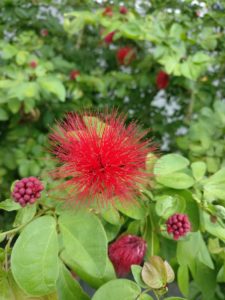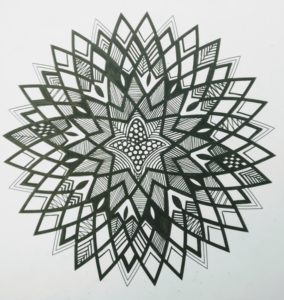I realized in my last post, I wanted to encourage everyone to try more mindfulness activities, but I didn’t give you a lot of guidance on what to do. So here we go, here are some mindfulness activities for adults that are easy to integrate into your day.
Using the 5 senses
At any point in the day, mindfulness activities can be useful to help us pause and regroup. We all know we have 5 senses, but how often do we put them all to use intentionally? Let’s try it! Get comfortable and start by noticing your breath.
Then begin with your ears.
Pay attention to the sounds around you. What can you hear? Try to identify five noises, tones, or vibrations. Don’t judge them as bad or good, just notice them. It may be your breathing, traffic outside, and air conditioner, or something completely different depending on where you are. Continue until you have identified five different sounds.
Then move on to your nose.
Pay attention to the smells around you. At first, you may think there aren’t any, but if you slow down your thoughts and pay attention, you should be able to pick some out. It may be a cup of coffee, newspaper print, or food from the kitchen.

Once you identify three smells, move on to your eyes.
Look in front of you and notice five objects. They may be things that you “see” every day, but now take the time to really look at them. Notice the color, texture, shape, and anything else that is interesting to your eyes in this meditative moment. Notice their size and any angles or corners they have. Trace the shapes with your gaze, notice how they are placed and any shadows they make. Then, when you are satisfied, move on to your mouth.
Taste the inside of your mouth.
Can you still taste something you ate or drank before you began this exercise? Maybe there is an aftertaste of coffee or that delicious breakfast you ate. Focus in on that taste. You may want to move your tongue around inside your mouth and see if there are other tastes inside your mouth. Just pay attention to the sensation when you are fully focused on your sense of taste inside of your mouth. Finally, shift your attention to your skin.
What can you feel?
Maybe it’s your clothing on your skin, maybe you are laying on silky sheets, or sitting in a supportive chair that feels firm and hard against your skin. Notice five different sensations on your skin. If you have trouble identifying them, start with your feet and work your way up noticing different areas of your body. You can also try this part of the exercise when you are in the shower or the pool for a different mindfulness activity.
You can do senses mindfulness activities anywhere at any time and experiment with how they differ in each place. If you have a tendency to get lost in meditation, just set an alarm for the amount of time you have available and explore where this goes! Give yourself 5 to 10 minutes minimum but don’t limit it if you don’t need to.

First Experience Mindfulness
Do you remember the first time you ever ate a strawberry? How about the first time you rode in a car or a bus? A fun exercise I like to do is to imagine what something would be like if I were doing it for the very first time. This could be walking down a certain street I see every day, eating a food I frequently eat or swimming for example. I try to recreate the newness of the situation and feel and the experience the same way I would as a child, or an alien, whichever you can relate to more.
If you want to take it a step farther, you can write about this experience. Use all of your senses to describe the experience as vividly as possible.

Mindful eating
Most of us eat at least a few times a day, unless we are very seriously into Intermittent Fasting. But as humans, we consume food. Some of us may do it while watching TV or scrolling through Instagram. So why not use that eating time to practice some mindfulness activities instead? Here’s how:
Remove all distractions from your eating space. You don’t need music or a youtube video to keep you company while you eat. Focus in on the sensations. Feel the spoon or fork in your hand. Observe the texture of the food you are eating, is it juicy, crunchy, creamy? How does the food smell? What does it feel like? Is it hot or cold? Just eat slowly and focus on the taste. Maybe you can identify what ingredients are in the food. Savor every bit and notice when you finish how satisfied you feel. To make this even more interesting, try it at a restaurant or when experiencing a new food for the first time.

Progressive Muscle Relaxation
This mindfulness activity is exactly what it sounds like. It was created by Edmund Jacobson and it is based on the premise that muscle relaxation blocks anxiety because muscle tension is the body’s psychological response to anxiety-provoking thoughts. While there are intense treatments that use this method under the care of a medical professional for most effective results, it can also be modified to help you relax in any situation. If you would like a detailed description of how to do it, I like the way its described here.
In simple terms, you identify a group of muscles, tense them for 20-30 seconds, and then release the tension allowing them to relax. For full body relaxation, you can start with the feet, move up to the calves, thighs, buttocks, abs, and so on until you have tensed and released all of the muscle groups in your body. This is a great mindfulness activity to do right before falling asleep to release any tensions you are holding from the completed day.

Mindful Walking
Whether you need to walk to get from point A to point B or you just want to take some time for mindfulness activities, walking is a great way to be in the moment. Find a place to walk, or use a route you are familiar with. If you are outdoors, make sure you are staying safe and aware. You can do this on a walking track, a treadmill, or even in hallways if you don’t have a good outdoor place to practice it.
While you are walking, pay attention to the lifting and falling of your feet. Notice any sensations in your body or shifting from side to side. Notice where your hands naturally fall, if your shoulders are relaxed. If your mind wanders, you can count steps up to ten and then start back at the beginning. Guide your attention back to the sensation of walking whenever your mind wanders.
For alternative mindfulness activities where you pay attention to your surroundings, I have a whole post about mindful photography here.

Mindful Appreciation
Some mindfulness activities don’t require you to set aside any time at all, they can take place slowly throughout the day. In the morning, set yourself the intention to notice 5 things that usually go unnoticed in your general day and to be grateful for them. This may mean appreciating that your mail arrives, or that the electricity is allowing you to have light and heat. It may mean saying thank you to the person cleaning up the tables in the cafeteria or taking out the trash. Throughout your day, keep a note of the things you notice that you appreciate but aren’t usually aware of. The next time you try it, increase your number from 5 to 7 things. Then go for 10. See how many things are all around you that go completely unnoticed.
This can also lead to a more defined gratitude practice if you enjoy it.

Mindful Art
You don’t need an adult coloring book to start coloring. Check out my post on Mindful coloring that includes a free PDF of bookmarks you can print out and color.
Or if you don’t like those, you can just type “Adult Coloring Pages” into google and print one out and dive in. Coloring is therapeutic and since the design is already done for you, it isn’t as overwhelming as a blank page. Choosing a color and filling in space is the only task, so don’t get overwhelmed by the end result. Just enjoy the journey and see where it takes you.



Mindful Breathing
Breathing is something we all do but don’t often think about. As simple as it sounds, it can be difficult to simply sit and pay attention to your breath. However, the benefits are totally worth the challenge, so try it out!
You don’t need to change the way you are breathing, just get comfortable and pay attention to the way you inhale and exhale. Feel the air in your chest or your abdomen. Feel the sensations of the breath in your mouth and your nostrils. Notice how when one breath ends, another always begins.
Be kind to your wandering mind. When extraneous thoughts pop into your mind, that’s okay, acknowledge them, and just let them float away and go back to focusing on your breath. Try to stay here just 5-7 minutes. The more you practice the easier it will get and you may find you want to spend more time on it.
Mindful breathing is known to help people calm down in stressful situations. If you are experiencing strong emotions, mindfulness activities like these can help you remain in control of your reactions to your emotions. They can reduce stress and empower you to feel more at ease.
Do you know more mindfulness activities?
I would love to hear about your experience! Post your ideas below!
Check out my latest posts here: